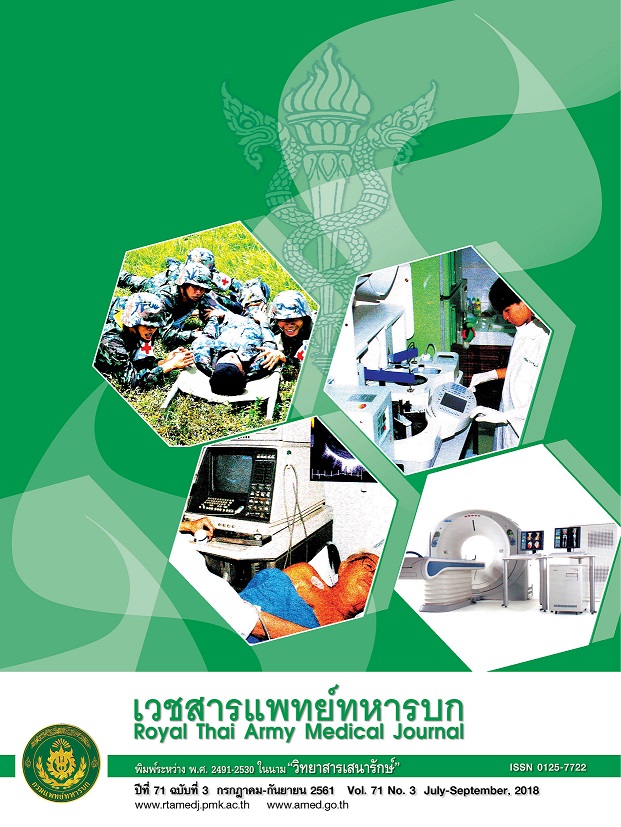An Undiagnosed of Placenta Accreta Presenting as a Massive Bleeding in Obstetric Emergency
Main Article Content
Abstract
Twenty-four-year-old Thai female couple patient had history of normal delivery in first pregnancy. Blighted ovum in second pregnancy was treated with uterine curettage. Right Ovarian tumor was diagnosed and surgery was performed before this pregnancy. This pregnancy received antenatal care since 5+6 weeks of pregnancy and placental previa was detected and spotting bleeding per vagina was found in first trimester. After follow up by transabdominal ultrasound was not seen placental previa and normal delivery at 38 weeks of pregnancy, only seven minutes after child delivery, placenta was not completed delivery but blood from vagina flowed all the time. Manual removal of placenta was done and found that some pieces of placenta adherent to the uterus and then severe postpartum hemorrhage occurred so there is an urgent hysterectomy. First day after surgery patient was cared in intensive care unit and later was moved to the postpartum ward. Patient was cared for 4 days until she was healthy and able to go home along with her children.
Article Details
References
Cheng KK, Lee MM. Rising incidence of morbidly adherent placenta and its association with previous caesarean section: a 15-year analysis in a tertiary hospital in Hong Kong. Hong Kong Med J. 2015;21:511-7.
Hung TH, Shau W, Hsieh CC, Chiu TH, Hsu JJ, Hsieh TT. Risk factors for placenta accrete. Obstet Gynecol. 1999;93:545-50.
Zhang D, Yang S, Hou Y, Su Y, Shi H, Gu W. Risk factors, outcome and management survey of placenta accreta in 153 cases: a five-year experience from a hospital of Shanghai, China. Int J Clin Exp Med. 2017;10:12509-51.
Khandaker S. An undiagnosed case of placenta percreta presenting as a massive hemoperitoneum in obstetric emergency. POG. 2014;4:3.
Usta IM, Hobeika EM, Musa AA, Gabriel GE, Nassar AH. Placenta previa-accreta : Risk factors and complications. Am J Obstet Gynecol. 2005;193:1045-9.
Allen L, Jauniaux E, Hobson S, Papillon-Smith J, Belfort MA. FIGO consensus guidelines on placenta accreta spectrum disorders: Nonconservative surgical management. Int J Gynaecol Obstet. 2018;140:281-90.
Balayla J, Bondarenko HD. Placenta accreta and the risk of adverse maternal and neonatal outcomes. J Perinat Med. 2013;41:141-9.
Rahimi-Sharbaf F, Jamal A, Mesdaghinia E, Abedzadeh-Kalahroudi M, Niroomanesh S, Atoof F. Ultrasound detection of placenta accreta in the first trimester of pregnancy. Iran J Reprod Med. 2014;12:421-6.
Owens WD, Felts JA, Spitznagel EL. ASA physical status classifications: a study of consistency of ratings. Anesthesiology 1978;49:239-43.
Andreatta P, Perosky J, Johnson TR. Two-provider technique for bimanual uterine compression to control postpartum hemorrhage. J Midwifery Women Health. 2012;57:371-5.
Kumari A, Sahay PB. A clinical review of emergency obstetric hysterectomy. J Obstet Gynecol India. 2009;59:427-31.
Cheung CS, Chan BC. The sonographic appearance and obstetric management of placenta accrete. Int J Womens Health. 2012;4:587-94.
Sharma V, Kaur J. Case report on placenta accreta presenting obstetric emergency. Int J Reprod Contracept Obstet Gynecol. 2017;6:2112-4.
Warshak CR, Eskander R, Hull AD, Scioscia AL, Mattrey RF, Benirschke K, et al. Accuracy of ultrasonography and magnetic resonance imaging in the diagnosis of placenta accreta. Obstet Gynecol. 2006;108:573-81
Bonnie KD, Victoria B, Lan T, Anjali R, Ian C, Richard B, Usha C. Prenatal Diagnosis of Placenta Accreta : Sonography or Magnetic Resonance Imaging? J Ultrasound Med. 2008 27:1275-81.
Ballas J, Pretorius D, Hull AD, Resnik R, Ramos GA. Identifying Sonographic Markers for Placenta Accreta in the First Trimester. J Ultrasound Med. 2012;31:1835-41.
Baughman WC, Corteville JE, Shah RR. Placenta accreta: spectrum of US and MR imaging findings. RadioGraphics. 2008;28:1905-16.
Hamisa M, Mashaly E, Fathy S, Tawfeek A. Role of Doppler US and MRI in diagnosis of placenta accrete. AJM. 2015;51:225-30.
Srinakarin J. ภาพวินิจฉัยแม่เหล็กไฟฟ้าของรกในครรภ์และ Placenta Accreta, Increta & Percreta. Srinagarind Med J. 2013;28(suppl):108-11.
Chitra S. Perioperative management of undiagnosed placenta percreta: case report and management strategies. Int J Womens Health. 2012;4:451-4.
Sentilhes L, Kayem G, Chandraharan E, Palacios-Jaraquemada J, Jauniaux E. FIGO consensus guidelines on placenta accreta spectrum disorders: Conservative management. Int J Gynecol Obstet. 2018;140:291-8.
Pliskow S, Dai X, Kohner A, Kapnick J. Conservative surgical management of placenta accreta: a report of 3 cases. J Reprod Med. 2009;54:636-8.
Kelekci S, Ekmekci E, Aydogmus S, Gencdal S. A comprehensive surgical procedure in conservative management of placenta accreta: a case series. Medicine (Baltimore). 2015;94:529.

